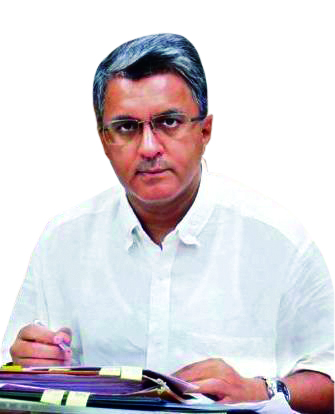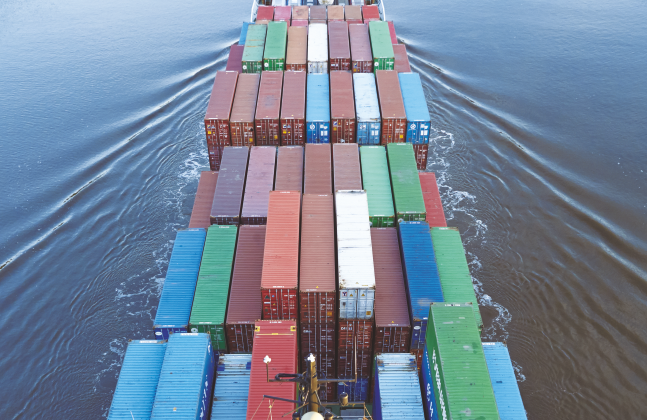IWAI has revamped the inland waterways by installing ultramodern cranes, jetties and has deployed barges that can sail in lesser draft, to ensure logistics happens in the waterways round the year. Sensing the opportunity a lot of companies are migrating to this cost-effective and eco-friendly mode of transport
India has about 15,000 km of waterways which have been totally neglected since the independence of our country. Nations like Bangladesh, Vietnam, Myanmar, US, China and Argentina have made immense progress in the use of their waterways, which are used at par with other modes of surface transport. In India the share of cargo movement through waterways has increased to about 6 per cent from about 0.5 per cent few years back. Now compare this with China that has more than 17 per cent of cargo moving through waterways, while Vietnam has 45 per cent. This also translates into environmental benefits for these nations. In November 2018, for the first time containerised cargo was flagged off from Kolkata to Varanasi through river Ganga and the ship also carried return cargo of Dabur and Pepsi from Varanasi and reached Kolkata on November 27. This important milestone disproved the notion that logistics in Ganga is not possible in the months of November and December, and can happen only during the monsoon season. Following this successful debut shipment, another cargo consignment of Emami products and Pepsi sailed from Kolkata to Patna. On 23rd November, 1,600 tonnes of stone chips were flagged off from a jetty in Pakur, Jharkhand to Bangladesh and there is daily cargo movement happening on this route. Containerised cargo movement is also happening from Haldia to Varanasi and then to Patna. Waterways are the answer to all the logistics issues such as high cost of moving goods through road, congestion in the city and traffic restrictions.
From 2 million tonnes in 2011 and 2012, cargo movement through waterways increased to 5.8 million tonnes in 2017 and by October 2018 about 6 million tonnes of cargo has been moved through the waterways. So, people are realising the importance and efficiency of waterways and the cost of logistics will force people to use waterways, if not today, in the near future.
“Nobody ever imagined that 1,233 tonnes of fly ash from NTPC could be loaded at Kahalgaon and moved to Guwahati in 21 days through the Indo-Bangladesh protocol route and the cost was 55 paise per tonne per km. This is one of the biggest consignments being transported on the waterways and no road or rail service can beat this costefficiency,” revealed Pravir Pandey, Vice Chairman, IWAI. But there is a challenge of return cargo. Major brands including Dabur, Parle-G, Emami and Hindustan Lever are looking at using waterways. If night navigation facilities are developed then further logistics time can be cut down on the waterways.
Coming to the Jalmarg Vikas Project Pravir Pandey revealed, the Sahebgunj multimodal terminal in Jharkhand will be ready by March or April 2019 and the Haldia multimodal terminal will be ready by the end of 2019. IWAI has put the Varanasi terminal for bidding through the PPP mode for 30 years on operations, maintenance and development model. The bidders include DP World, JM Baxi and Adani. The government is not going to operate any terminal actively, but will undertake maintenance of the waterways. IWAI is deploying staff on water with echo sounders and other equipment for channel marking and monitoring their depths, so that uninterrupted movement of cargo and passengers takes place.
The NW-4 has become operational on Krishna River and more than 50,000 tonnes of cargo is moving on this route. 90 kms of this waterway from Muktyala to Vijayawada is being developed and in-between the new capital city of Amaravati is coming up.
Seeing the development on Ganga – NW-1, the government is planning to develop Brahmaputra (NW-2) for which the World Bank will fund Rs.3,000 crore. Moving further to connect with the South East Asian nations, the Kaladan multimodal transit project in Myanmar is being funded by the Ministry of External Affairs at a cost of `700 crore. The idea is to connect Kolkata and Haldia to Myanmar at Sittwe which further connects to Mizoram. The Sittwe port is now ready for operations and this project will not only make connecting the north east states easy but will also open India to the South East Asia. Special vessels that can move on lesser draft are being designed for moving containers, bulk, break-bulk and Ro-Ro on the waterways. About 15 such vessels will be procured. 10 Ro-Ro vessels are also being procured from Cochin shipyard and the first vessels will be delivered in February or March 2019.

Pravir Pandey
Vice Chairman, IWAI
Nobody ever imagined that 1,233 tonnes of fly ash from NTPC could be loaded at Kahalgaon and moved to Guwahati in 21 days through the Indo-Bangladesh protocol route and the cost was 55 paise per tonne per km. This is one of the biggest consignments being transported on the waterways and no road or rail service can beat this cost-efficiency.
IWAI is very keen to use methanol as marine fuel in ships plying on waterways. Niti Aayog is piloting this movement and a committee chaired by Dr Saraswat, Member, Niti Aayog, is formed for promoting use of methanol. IWAI has given three of its boats to Cochin shipyard to redesign and retrofit its engines for using methanol. IWAI has also placed orders with Cochin Shipyard for 6 cargo vessels having 1000-2000 tonnes capacity that run on methanol. Methanol costs Rs.25 per litre as compared to Rs.65 per litre of diesel, so it can drastically bring down the logistics cost by about one third.
A concern in using methanol is for bunkering, because if a ship sails from Kolkata to Patna then it will need refuelling in the journey and methanol can’t be stored in huge quantities like diesel as it needs more space onboard a ship which will reduce cargo holding capacity. So ships will need frequent bunkering, maybe after every 500km. IWAI is also planning bunkering and fuel supply strategy on the national waterways.
A lot of thought process was put for using barges from Goa that were defunct after the ban on mining there. But those barges need a draft of 2.8 meters. While waterways have a draft of 3 meters from Haldia till Patna, but beyond Patna the draft is 2.5 meters. IWAI is also in the process of buying 25 vessels of various kind – bulk, break-bulk, container carriers, Ro-Ro, oil tankers, push tug flotilla. About 10-12 barges are already moving on the waterways. These barges will be given on lease to private companies to operate, but beyond that the private companies need to invest in barges.
Logistics service providers, instead of owning 100 trucks wherein each truck costs about `5-6 crores, they can invest in one vessel of 1500-2000 tonnes capacity that costs about `10- 11 crores. Once the benefits of using waterways are realised, confidence will build up among the logistics service providers who will gradually move from trucks to vessels.
The first challenge for waterways transportation was cargo handling cost, because loading and unloading of cargo was manual due to which the cost was skyrocketing, but use of mechanised equipment for cargo handling has helped to control the cost. Today at multimodal terminals in Varanasi, Sahebgunj, Haldia, Pakur, Kalughat and Ghazipur, most modern cranes and mobile harbour cranes are being installed, the jetties are designed for high level and low level boats. For example, the Pepsi cargo consisting of 16 containers that reached Banaras was offloaded in 52 minutes.
IWAI is acquiring 100 acres land in Banaras, 350 acres in Sahebgunj for developing freight villages that will attract and aggregate the cargo. All operations from manufacturing to assembling and packaging, warehousing, bonding can happen in the freight village. These villages will have multimodal connectivity to waterways, road and rail. The shipper can choose a combination of the transport mode based on his cost and convenience.
At Sahebgunj in Jharkhand, moving beyond the freight village, an industrial hub is being planned for which 350 acres land is being acquired. These freight villages are expected to be operational by 2020. IWAI will acquire land and develop the basic infrastructure such as roads, water and electricity supply, and thereafter through PPP mode land will be given to a private operator to develop.






